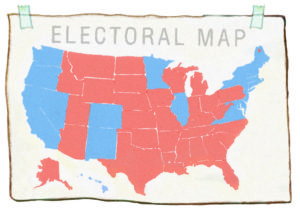Voting from home may be their last best chance
How to Bring Home Democratic Voters
By Phil Keisling
Donald Trump wasn’t the only disaster for Democrats in 2016.
Despite a favorable U.S. Senate map—Republicans were defending twenty-four seats compared to the Democrats’ ten—and what was supposed to be a negative Trump effect on down-ballot races, the Democrats gained a measly two seats, not enough to regain the majority. They took back just six seats in the House of Representatives, where the GOP retains a forty-seven-seat advantage. At the state level, Republicans won three new governorships, pushing their total to thirty-three, the most since 1922. They now control both houses of thirty-two state legislatures, also a modern record.
If 2016 was a train wreck for Democrats, the 2018 midterms could herald an electoral version of nuclear winter. Democrats must defend twenty-five U.S. Senate seats in 2018; the Republicans, only eight. The last two midterms have been disastrous for House Democrats, who lost sixty-three seats in 2010 and thirteen more in 2014. More state legislative losses in 2018 could dig a hole so deep that even a 2020 Democratic “wave election” could still leave Republicans in control of most states’ 2021 congressional and state legislative redistricting efforts.
Meanwhile, a Jeff Sessions–led Department of Justice, abetted by a conservative Supreme Court majority, will likely go from fighting voter suppression efforts to defending and even advocating them—using the myth of voter fraud as a pretext to make it ever harder for minorities and young people to vote.
There’s a reason Republicans focus so much on making it hard to cast a ballot: they know they generally do better when fewer people vote. Indeed, for all the talk of how the Democrats need to rethink their message, the simple fact is that their biggest problem is low turnout. Even in the 2016 presidential year, sixty-four million registeredvoters didn’t show up. The problem is far worse in midterm elections, the real killing fields for Democrats’ dreams in recent years. In 2014, 57 percent of all registered voters—almost 110 million people—sat out the election. The ones who did show up were disproportionately white and older—and voted heavily Republican.
Democrats and their progressive allies have no choice but to keep resisting voter ID laws and polling place closures. Wherever possible, they should also push such important reforms as automatic voter registration. But the first strategy is simply playing defense, and the second is relatively small-ball offense. Far more important, both for Democrats and for the basic health of our democracy, is to finally go on the attack with a much bolder strategy. It’s time to get serious about eliminating the most powerful and ubiquitous voter suppression device of all: the traditional polling place.
Implementing “vote from home”—also known as universal vote by mail—is the most promising way to significantly increase voter turnout, especially among young people and minorities. Three states—Colorado, Oregon, and Washington—already have vote from home election systems. Here’s how it works: instead of requiring voters to cast ballots at official polling places or apply in advance for absentee ballots, these states mail ballots to all registered voters at their homes. Voters then have about two weeks to fill out their ballots and either mail them back or deliver them personally to any one of hundreds of official ballot drop sites located strategically across their states—in, for example, schools, libraries, police and fire stations, and post offices, and at secure, free-standing metal boxes that are available twenty-four hours a day. For security, election officials match the signature on every ballot with the one on the voter’s registration card.
Vote from home makes some of the standard voter suppression tactics—requiring photo ID, closing polling places to create intentionally long lines—impossible to execute. Hundreds of millions of ballots have been mailed out in the three vote from home states since 2000; fraud and other forms of electoral mischief have been non-issues. In November 2016 alone, about thirty million more Americans safely and securely voted absentee—universal vote by mail’s inferior cousin, in which voters must request and qualify for a mail-out ballot, rather than the state automatically sending one—with nary any fraud. Vote from home also saves state and local taxpayers millions of dollars each election cycle, because administering polling locations is expensive. Most important, it raises turnout. And the evidence is also mounting that the voters it brings into the fold are disproportionately young people and people of color—in other words, voters more likely to choose Democrats.
Little wonder, then, that Republican legislative leaders have fought vote from home at almost every turn. With Democrats in full control of just six state governments following the 2016 election, the path to universal vote by mail via state legislatures is not promising.
It’s time to get serious about eliminating the most powerful and ubiquitous voter suppression device of all: the traditional polling place.
But here’s the good news. In twenty-one states that don’t already have vote from home, including several crucial electoral battlegrounds, citizens have the right to change the law via ballot initiative. In these states, proponents can go straight to the people. And people like voting from home, because it makes democratic participation easier no matter what party they belong to. (An October 2016 poll by DHM Research found that 87 percent of Oregon voters had a positive impression of the system; even Trump voters loved it.)
With enough financial backing, universal vote by mail could be on the November 2018 ballot in a dozen key states, including Florida, Michigan, Ohio, Arizona, and Nevada. If any of those measures pass, the turnout boost in 2020 could help Democrats regain the presidency, win back seats in the U.S. Senate and House, and take back enough state legislatures to minimize the damage of GOP-controlled redistricting in 2021. An even bigger turnout boost could then come in the 2022 midterms—especially if more states joined the movement by approving ballot measures in 2020.
The message for Democrats and their progressive allies is clear. It’s important to help more people register to vote. But if most registered voters don’t cast ballots—especially in midterm elections—it isn’t going to move the needle much. Unless Democrats want to live under permanent Republican control of government, their focus needs to shift—and quickly—to ensuring that already-registered voters actually cast their ballots. And that means getting vote from home up and running in as many states as possible.
To see how big an impact vote from home would have, just look at what has happened in the states that already use it. Turnout in Oregon, my home state, used to be buoyed by demographics: through the early 1980s, income and education levels were above the national average, and 93 percent of the population was white.
But by 2000, Oregon’s timber industry had collapsed and our population had grown steadily poorer and more diverse relative to the rest of the country. (Today, Oregon’s per capita income is 91 percent of the national average, and only thirteen states have a larger Hispanic share of population.) Meanwhile, from 1980 to 1998, turnout of registered voters fell from about 77 percent to 71 percent in presidential elections, and from about 77 percent to 59 percent in midterms. That decline looked set to continue.
But in 1998, Oregon voters approved a universal vote by mail system. In the 2000 presidential election, voter turnout leaped to 80 percent and has since climbed as high as 86 percent, while midterm turnout rebounded to an average of 71 percent. This decade of higher turnout happened even as Oregon lost its status as a presidential battleground and was seeing far fewer competitive statewide elections.
While some researchers have questioned the effectiveness of universal vote by mail, these critiques often measure turnout in terms of the “voting-eligible population” rather than registered voters. Vote from home obviously can’t get unregistered voters to register; it targets, instead, the far larger number of citizens who are already registered but don’t consistently vote. And much of the criticism isn’t based on the actual experience of Colorado, Oregon, and Washington, but rather draws inferences from absentee voting, which is fundamentally different. (More on that in a moment.)
It’s important to recognize that vote from home will have the biggest impact not in presidential races but in midterm elections, where turnout is much lower and skews heavily older and whiter. This is easiest to see by looking at midterm turnout among “active registered voters,” meaning the segment of the population that votes at least during presidential elections. Using that metric, the three vote from home states averaged 66 percent turnout in 2014, with Colorado and Oregon cracking 70 percent. The national average, meanwhile, was just 48 percent, according to federal Election Assistance Commission data.
A 2013 study of Washington’s system, which was adopted county by county, found that while universal vote by mail boosted a county’s overall turnout by 2 percent to 4 percent, the effect was even more pronounced for groups with traditionally lower participation rates—that is, younger and minority voters. A study of local 2015 elections in San Mateo County, one of a few California jurisdictions to experiment with vote from home, found similar results. (Asian Americans, in particular, were 30 percent more likely to vote.) And a March 2015 analysis of twenty-six states by the research organization Latino Decisions found that while just 32 percent of registered Latino voters cast ballots in those states in the 2014 midterm election, that number hit 54 percent in Oregon and Colorado.
Vote from home also increases the rate of ballot casting among younger registered voters. My analysis of 2014 data from Oregon’s complete voter files found that the turnout of eighteen- to thirty-four-year-old registered voters—again, in a relatively quiet, midterm election—was 46 percent, compared to far lower rates in traditional battleground states like Ohio (16 percent), Pennsylvania (20 percent), and North Carolina (22 percent).
Should the fact that older voters love absentee ballots give Democrats pause about expanding mail-in voting? No. There’s a crucial difference between absentee voting and universal vote by mail: since getting an absentee ballot requires extra effort, it attracts already-motivated voters. In a vote from home system, by contrast, the ballot simply shows up at the home of every registered voter. To put it in behavioral economic terms, vote from home transforms voting from “opt in” to “opt out,” at least among registered voters.
Combining universal vote by mail with automatic voter registration, as Oregon became the first state to do in 2016, is an especially powerful combination. But it’s important to recognize which reform does more to drive turnout. While 82 percent of previously registered Oregon voters cast a ballot for president in 2016, just 43 percent of newly automatically enrolled voters did—a number that would likely have been far lower in a traditional polling place election, especially in midterms.
In short: getting vote from home on the ballot in 2018 could make a material difference in 2020; by the 2022 midterms, Democrats could start gaining ground between presidential elections rather than losing it.
Twenty-four states, including the three with universal vote by mail, allow citizens to force a statewide vote on ballot measures, provided they collect enough valid signatures. Vote from home advocates should focus on getting measures on the ballot in 2018 in the dozen states where ballot measure campaigns would either be easiest to qualify or have the biggest impact. And while higher voter turnout is in Democrats’ current self-interest, advocates should emphasize the broader, nonpartisan point that making voting more convenient for everyone strengthens democracy—while saving taxpayers millions of dollars in election overhead.
Vote from home could be on the 2018 ballot in a dozen key states, including Florida, Michigan, and Ohio. The turnout boost in 2020 could help Democrats regain the presidency, win back seats in the U.S. Senate and House, and minimize the damage of GOP-controlled redistricting.
The highest-impact states are Florida, Michigan, Missouri, and Ohio, battlegrounds that collectively represent seventy-three electoral votes. In all of these but Michigan, Republican incumbents will be defending their U.S. Senate seats in 2022. Funding the campaigns just to get on the ballot in these states would cost about $3 per signature, for a total of about $4 million; Florida alone would take up half of this, since an initiative would need to amend the state’s constitution. Expect Republican Party opposition to be fierce, so actually passing these measures will require a lot more money and organization. (Missouri voters in particular could be harder to persuade, since their state has very little experience with absentee voting.) But the payoff of getting vote from home passed in even one of these states would be well worth the expense.
If the 2020 presidential election is close, universal vote by mail could make a crucial difference. Consider Michigan, where 64 percent of about 7.5 million registered voters cast a ballot in 2016 and Donald Trump won by fewer than 11,000 votes. If vote from home had been in place and had boosted registered voter turnout by just two percentage points, 150,000 more votes would have been cast. If those extra voters had gone 54 percent or more for Clinton, she would have won that key state.
 Scott Peck
Scott PeckAnother seven states to target in November 2018 would be Alaska, Arizona, Montana, Nevada, North Dakota, South Dakota, and Utah. Getting measures on the ballot in these states would be cheap: vote from home supporters would only need to gather a total of around 450,000 signatures, at a cost of about $1.5 million, to qualify in all seven. Nevada is a vital Democratic-leaning swing state, and Arizona is moving in that direction. The others are more traditional red states, but targeting them makes sense for several reasons.
First, even reliably red states elect Democrats to statewide office: Montana has a Democratic governor; North Dakota, a Democratic U.S. senator. Second, six of these states have Republican U.S. senators up for reelection in 2020 (Alaska, South Dakota, and Montana) or 2022 (Arizona, North Dakota, and Utah), and higher voter turnout could make these seats more competitive. Third, residents in most of these states have considerable experience with voting via mailed-out absentee ballots; in Arizona and Montana, more than half of the votes cast in 2014 came through the mail. Let Republicans try to convince their own elderly constituents that their beloved mail-in ballot is actually a recipe for fraud. Finally, these states present more opportunities for proof of concept: the more places where citizens get used to vote from home, the harder it will be for opponents to keep it from spreading.
Running viable campaigns in all twelve of these states could require $50 million to $100 million over two election cycles. That may sound like a lot, but it’s a drop in the bucket compared to what is spent on traditional field operations and other “get out the vote” efforts that are less effective than universal vote by mail. Consider, too, that in California alone, marijuana supporters raised around $23 million to support the 2016 legalization effort, with almost half of that coming from billionaires Sean Parker and George Soros. A multistate vote from home effort would be a far higher impact investment for wealthy, civic-minded liberal donors.
There are also a handful of states with Democratic governors and Democratic-controlled legislatures that could pass universal vote by mail legislation without the need for ballot initiatives, such as Hawaii. California already has started down this path: in September it enacted Senate Bill 450, championed by Democratic Secretary of State Alex Padilla, which allows counties to opt into vote from home one by one. California may be a solidly blue state, but it still has almost 10 percent of the nation’s congressional seats; ensuring higher turnout there in 2018 could help Democrats make gains in the House. Illinois is another large Democratic-controlled state (with fast-growing absentee ballot use) where legislators could enact vote from home—though at present, the governor is a Republican.
While expanding universal vote by mail may be a survival strategy for the Democrats, it isn’t—and shouldn’t be framed as—a purely partisan issue. Anemic turnout is a dangerous sign for a democracy. It’s also a major reason we’ve ended up with such extremist government, since low-turnout elections amplify the influence of motivated, hyper-partisan voters on both sides. (This is especially true in party primary elections; in 2014, turnout of registered voters averaged less than 20 percent.)
Three million more Americans voted in 2016 than in 2008, but that didn’t come close to keeping up with population growth. Just 59 percent of eligible citizens voted in 2016, for the lowest turnout percentage since 2000 and the largest number of no-shows in a presidential election in U.S. history. That came on the heels of the 2014 midterms, which set an even more dismal record of 36 percent of eligible citizens casting a ballot—the lowest level since World War II.
The system we have is simply not working. Vote from home may be our last best chance—not only to stave off the damage of a Trump presidency and Republican hegemony, but also to revive a system of participatory democracy that has steadily become less and less participatory and less democratic.



















